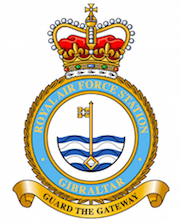To coincide with the 100th anniversary of the formation of the Royal Air Force, Government have announced that, in the May sitting of Parliament, it will move a Motion to confer the Freedom of the City on RAF Gibraltar.
HISTORY OF RAF GIBRALTAR (based on an article by Air Cdr H Probert)
Two RAF camps were constructed in Gibraltar at the beginning of the Second World War. The first was RAF North Front on the site of the old racecourse which was to become the main camp. The second was RAF New Camp which was built on reclaimed land next to Montague Bastion. Although these were the first permanent RAF camps in Gibraltar, the history of aviation and the RAF’s involvement starts somewhat earlier.
The first record of aviation in Gibraltar was in 1903 when two officers and 16 Non-Commissioned Officers installed a captive balloon and equipment to Gibraltar for reconnaissance at the southern end of the Rock.
The idea of an airfield in Gibraltar dates back to the 1920's when the then Governor of Gibraltar and his counterpart in Algeciras formulated a plan to construct a landing strip. However, the plan was rejected by both the Spanish and British governments. Permission was granted to operate an air passenger service from Gibraltar to Tangier in 1931. The service operated from the racecourse but was terminated after only three months due to maintenance difficulties.
Work began on a grass strip on 3rd September 1934 and was completed 18 months later on 10th March 1936, all for the princely sum of £573. It was during this construction period that the RAF first dispatched military aircraft to Gibraltar. Construction of a solid surface runway began in late 1939 and land reclamation commenced towards the end of 1941 along with the construction of the RAF camp at North Front. Following the declaration of war with Germany in September 1939, the War Office realised that there was a strong possibility of German submarines concentrating in the Strait of Gibraltar and using Spanish port facilities.
At 0900 on the 9th September 1939, No 202 Squadron was ordered to Gibraltar, heavily loaded with equipment. Shortly after the Squadron’s arrival, No 200 Coastal Group was formed with its headquarters in the Bristol Hotel. It operated as part of RAF Mediterranean Area and later a combined HQ was formed with the Royal Navy at the Tower in the dockyard. This began anti-submarine patrols in early 1942. It took the fall of France in 1940 to concentrate minds on the building of a proper runway.
At the end of November 1941 it was decided that the runway should be extended seaward to give a total length of 1550 yards. Construction teams were brought from the UK and they used stone blasted from the north face of the Rock and dumped into the sea along with stone taken from tunnel construction. The extended runway was ready for use in July 1943 but towards the end of that year operations in Gibraltar began to dwindle in number. However, there was no reduction in transit aircraft.
The RAF North Front’s biggest moment came on the night of 7/8 November 1942 when no fewer than 650 aircraft of many types were parked along both sides of the runway in readiness for operation TORCH, the Anglo-American invasion of North Africa. In his memoirs, Churchill called it, ‘Gibraltar’s greatest contribution to the War.’
In October 1944 RAF New Camp became a satellite of North Front.
Considering the number of aircraft movements during the war there were relatively few accidents. the most famous being on 4th July 1943 when a Liberator carrying the Polish Prime Minister Sikorsky crashed shortly after take-off, killing everyone except the pilot.
In the early post-war days, there were regular detachments of Lancasters which replaced the Liberators in Coastal Command – for training purposes, for Meteorological operations for Search and Rescue and so on. Then, with the onset of the Cold war, maritime patrolling over the eastern Atlantic and into the Mediterranean became essential and, in 1951, the Halifaxes of the resident unit, No 224 Sqn, began to be replaced by Coastal Command’s newly-introduced Shackletons. These played their part in the growing number of NATO exercises which took advantage of the local facilities.
In 1955 the runway was extended to its current length of 6000 feet, a length which supports all current day RAF aircraft apart from Voyager aircraft.
By 1964, the UK Government had begun talks with Gibraltar’s Legislative Assembly about the possibility of granting independence which ran counter to Spain’s aims for reunion with Gibraltar. In October of that year the Spanish stepped up their border controls and, as a result, two RAF Hunters were sent out to the Rock. Their pilots were delighted to be encouraged to engage in low flying without any noise abatement procedures!
From the non,tensions grew as Spain tried unsuccessfully to stop NATO from using the airfield. The situation was not improved in January 1966 when two American aircraft, one carrying nuclear weapons, collided over Palomares. Later that year, during London discussions with Spain, the UK firmly insisted on its sovereignty over the whole territory of Gibraltar and included the telling phrase, ‘all up to the frontier fence’ – which, of course, included the airfield. Spain responded by banning RAF aircraft from overflying her territory. This was followed by a singularly ill-timed British government decision to disband No 224 Sqn as part of cuts in defence expenditure.
In April 1967, Spain imposed her ‘SPA’ - Spanish Protected Airspace – around Algeciras, necessitating special manoeuvres by aircraft approaching and taking off from the west and Spanish F-86 Sabres followed up with fairly intrusions over the airfield. The people of Gibraltar responded to these threats by voting almost unanimously to stay with the UK whereupon, in 1968-69, further frontier restrictions culminated in its complete closure and the stopping of the Algeciras ferry.
In 1970s witnessed a steady growth in the amount of Soviet naval shipping through the Strait as well as making use of several anchorages off the east coast of Morocco; two of these – Alboran Island and Melilla – were frequently reconnoitred. The importance and extent of such operations were recognised in 1971 by the introduction into Gibraltar of the one-star post of Air Commander. Then, two years later, the office of Governor and C-in-C Gibraltar was filled for the first time by an RAF officer, the former Chief of the Air Staff, Sir John Grandy.
Grandy was still in post in 1975 when Franco died. Slowly but surely, Spain’s new leaders began discussions with the UK, not least since they wanted UK’s support for joining NATO and the EEC. The outcome was an agreement to consider easing frontier restrictions on the 20 April 1982.
A spanner was thrown into the works on 2 April when Argentina invaded the Falklands followed by the UK's decision to despatch a Task Force. The parallel between Argentina’s claim on the Falklands and Spain’s claim to Gibraltar was obvious to politicians in Madrid and the fact that Gibraltar was used to support the task force only made matters worse. As a result, the re-opening of the frontier was postponed. Extra security measures were introduced at RAF Gibraltar at the same time as the airfield provided staging facilities needed by Hercules transport aircraft en route to and from Ascension. By the time the conflict ended in mid-June, RAF Gibraltar had supported 325 visits by Hercules aircraft.
Since the 1980s, RAF Gibraltar has settled into a new role of providing an operational deployment and staging facility and a strategically important Forward Operating Base from which aircraft, personnel and equipment can be deployed as required. As well as in the Falklands conflict, it was extensively used in this role during the Gulf Wars, and the Bosnia and Sierra Leone interventions. Also, its unique location at the gateway to the Mediterranean continues to offer an invaluable training facility to RAF, RN and allied crews.
BRIEF HISTORY OF THE RAF
The first air units in Britain’s military were formed eight years after the first powered flight took place in 1903. In April 1911 an air battalion of the Royal Engineers was formed, consisting of one balloon and one airplane company. In December 1911 the British Admiralty formed the first naval flying school, at the Royal Aero Club ground at Eastchurch, Kent.
In May 1912 a combined Royal Flying Corps (RFC) was formed with naval and military wings and a Central Flying School at Upavon on Salisbury Plain. The specialised aviation requirements of the navy made it appear, however, that separate organisation was desirable, and on July 1, 1914, the naval wing of the RFC became the Royal Naval Air Service (RNAS), the military wing retaining the title Royal Flying Corps.
On the outbreak of World War I in August 1914, the RFC, possessing a total of 179 airplanes, sent four squadrons to France. On 1 April, 1918, the RNAS and RFC were absorbed into the Royal Air Force (RAF), which took its place beside the British navy and army as a separate service with its own ministry under a secretary of state for air. The strength of the RAF in November 1918 was nearly 291,000 officers and airmen. It possessed 200 operational squadrons and nearly the same number of training squadrons, with a total of 22,647 aircraft.
To train permanent officers for the flying branch of the RAF, a cadet college was established at Cranwell, Lincolnshire, in 1920. The RAF staff college was opened in 1922 at Andover, Hampshire.
At the outbreak of World War II in September 1939, the first-line strength of the RAF in the United Kingdom was about 2,000 aircraft. The RAF fighter pilots, however, distinguished themselves during the Battle of Britain in the early stages of the war against the numerically superior German Luftwaffe. By the time the war ended, the strength of the RAF was 963,000 personnel. When the wartime forces were demobilised in 1945, however, the total strength of the RAF was reduced to about 150,000, the approximate number retained into the 1980s. That number had dropped significantly by the early 21st century as part of an overall force-reduction strategy implemented by the British military. With 40,000 troops and just over 300 combat-ready aircraft, the RAF was a smaller, more-focused force than it had been in previous years. Despite its reduced size, the RAF remained a potent instrument for projecting British influence across the globe, as demonstrated in wars in Afghanistan and Iraq as well as the 2011 NATO air campaign in Libya.


